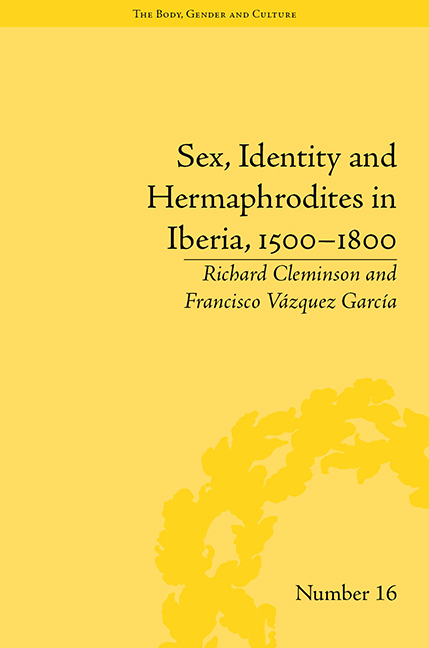Book contents
- Frontmatter
- CONTENTS
- Acknowledgements
- Introduction: Sex, Gender and Historicity
- 1 Marvels, Monsters and Prodigies: Hermaphrodites as Natural Phenomena in Spain, 1500–1700
- 2 Sexual Transgression and Hermaphroditism: The ‘New World’ and Imperial Subjectivity
- 3 The Expulsion of the Marvellous: The Decline of the ‘One-Sex’ Model, 1750–1830
- 4 Hermaphroditism in Portugal
- Conclusion
- Notes
- Works Cited
- Index
Conclusion
- Frontmatter
- CONTENTS
- Acknowledgements
- Introduction: Sex, Gender and Historicity
- 1 Marvels, Monsters and Prodigies: Hermaphrodites as Natural Phenomena in Spain, 1500–1700
- 2 Sexual Transgression and Hermaphroditism: The ‘New World’ and Imperial Subjectivity
- 3 The Expulsion of the Marvellous: The Decline of the ‘One-Sex’ Model, 1750–1830
- 4 Hermaphroditism in Portugal
- Conclusion
- Notes
- Works Cited
- Index
Summary
This book has attempted two principal undertakings. Firstly, it has tried to place scientific, theological and, to a lesser degree, although the three cannot be separated, social and cultural discourse on hermaphroditism in Iberia within its own context and frame of reference. By this we mean that the framework of intelligibility for the textual treatment of hermaphroditism in Iberia has been progressively analysed on the basis of the scientific and religious discourses of the time and, especially, within the cultural constraints governing ideas and practices on sex and ‘gender’. Throughout, we have sought to avoid any hint of essentialism in our analysis whereby acts, behaviours and discourses are considered in light of current considerations on phenomena such as ‘transsexualism’, ‘homosexuality’ and ‘gender crossing’. As Foucault has argued, discourse is not complicit with our current knowledge; there is no pre-discursive providence that disposes us towards its ‘truths’. Instead, we have chosen to employ and to reveal the meanings of terminology that reflect the concepts and discourses utilized during the three hundred or so years considered here, 1500–1800, which, although they altered perceptibly, cannot be seen as simple ‘precursors’ to later descriptors or frameworks of understanding. Hence, we have employed and interrogated the meanings of ‘hermaphroditism’ and ‘sex change’, the significances that surrounded what it meant to be a man or a woman, and the outward and inward signs that appeared to prove this status to doctors, inquisitors and theologians who examined ‘ambiguous’ or doubtful cases of sexual identity.
- Type
- Chapter
- Information
- Sex, Identity and Hermaphrodites in Iberia, 1500–1800 , pp. 111 - 114Publisher: Pickering & ChattoFirst published in: 2014



